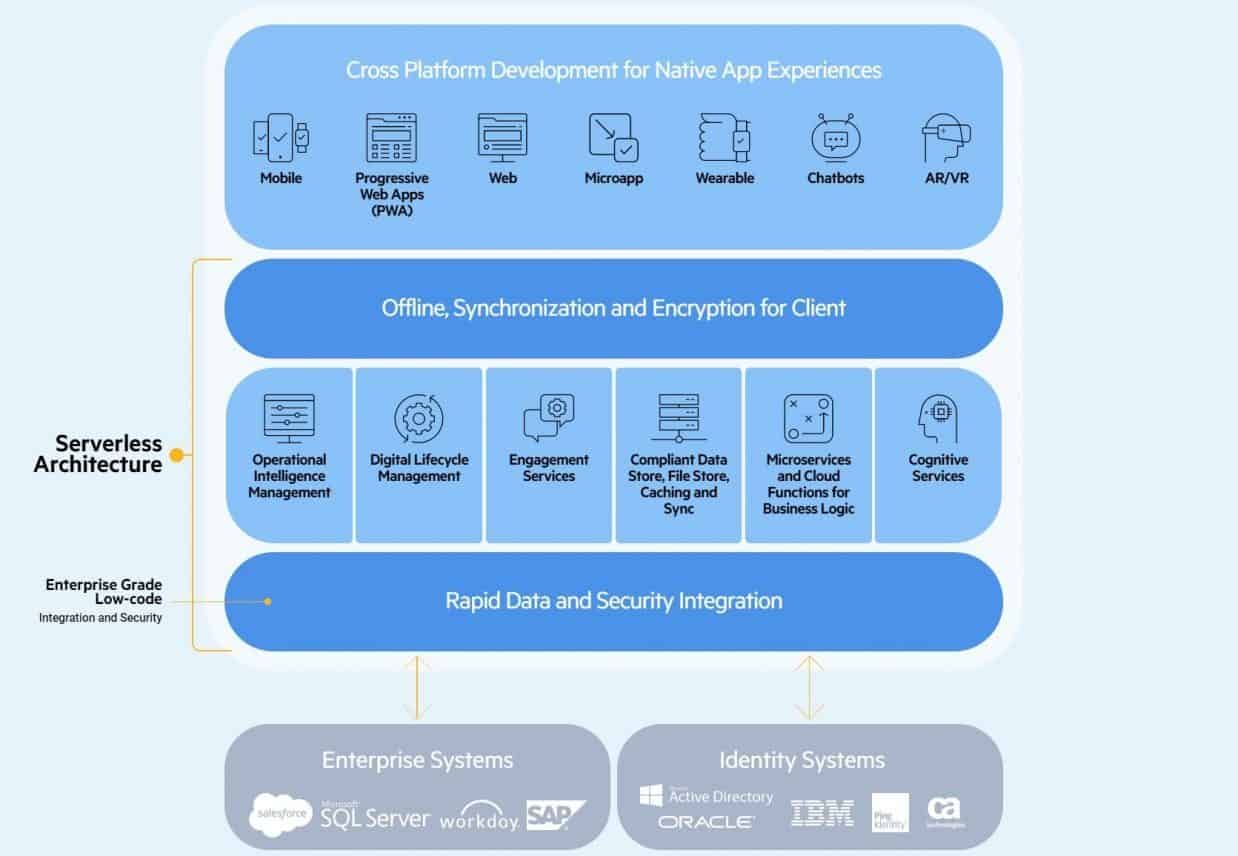Progress has been working for quite some time to expand its platform to the central place where developers perform their development tasks. This is to support organizations in one of their top priorities: building simple applications. By developing simple applications, their existing processes are accelerated. A webshop where a customer can use a mobile app, for example, is often more user-friendly than a webshop with little mobile functionality. Progress has a broad core portfolio for the development of all stand-alone applications. The Kinvey platform and the NativeScript framework attract a little extra attention within this portfolio because of their cloud-native and innovative character.
The changing IT landscape has caused development work to change significantly. Few companies thought about releasing an iOS and Android app just over a decade ago, and serverless development was not such a popular technology. Nowadays, both iOS and Android apps are almost a must, and serverless has become an indispensable component for many developers. Serverless has made it possible to focus more on the app, instead of working on all kinds of infrastructure tasks such as maintenance and monitoring.
Progress has kept an eye on these kinds of developments. In doing so, it has looked at how best to align its portfolio with the development work of developers. Well-known Progress technologies are, of course, part of this portfolio. OpenEdge, for example, is Progress’ platform that is still widely used for the development of applications. These kinds of trusted solutions will continue to receive updates. Much newer in the portfolio, however, are Kinvey and NativeScript.
Kinvey has become a core element in a short period of time
Kinvey is the relatively new name in the Progress portfolio, as this technology was acquired in mid-2017 by means of an acquisition. The startup Kinvey was able to offer various possibilities for software development from the cloud, offering a mobile Backend as a Service. Progress was looking for a number of technologies that it did not have in-house, and it also saw the potential for Kinvey to play a prominent role within the portfolio. The platform developed further and some components were added. We are now talking about a platform on which developers can find ‘Lego Blocks’ to build web, chat, iOS and Android apps. Progress believes it is important that the development process takes place in a simple and fast manner.
Some examples of Kinvey parts:
- js microservices – Microservices make an application modular by focusing the application on small services. By performing specific tasks, the small services are very good at what they have to do and can thus form the basis of a good application. In this case, the microservices are written in JavaScript, the development language on which Kinvey is based. JavaScript is popular for developing web applications, but mobile apps can also be made with it. NativeScript can play a role in this, more about this later.
- Data issues – When building applications, all kinds of data issues can arise. This can include the collection of data from other sources. Kinvey offers connectors for this. Some of the connectors it offers as standard are, for example, Microsoft SQL Server, Salesforce, SAP and its own Progress OpenEdge platform. Suppose that an app has to be created for the field service department. It is then quite normal that data is extracted from two sources. In Salesforce the account data can be found, while the order information is in SQL Server. From a development perspective, two backend services are created with the aforementioned connectors. Kinvey offers the management features with which developers ensure that the data of both services work smoothly with each other and that there is also some built-in security.
- Security – Kinvey runs on AWS, a cloud platform that has proved its worth in terms of security. AWS has built-in standard security features, for example for automatic security assessments, with which users can actually protect virtually all their data. They only have to set up their own firewalls and arrange security components such as a CASB. Progress has also built in some extra security standards through its collaboration with AWS. These standards focus on data encryption and user authentication, among other things.
- Artificial intelligence and analytics – When software developers collaborate with data scientists, a more powerful application can be created. Companies, for example, devise an application that has to solve a complex business issue, but a developing team does need certain insights to do so. By calling in the help of data scientists, large amounts of data can be analyzed in order to arrive at valuable insights. These can be passed on to the developers on the Kinvey platform by means of connectors.
Simplicity lies in low code for professionals.
The platform has even more components that take into account certain development activities. Ultimately, Progress wants Kinvey to make the work of professional developers as simple as possible. This is done by means of ‘low code for professionals’, as they describe it. For example, it offers low code functionality for building the user interface.

What low-code actually brings about is that applications are built using a drag-and-drop editor. By working with such a visual interface, productivity can increase. Programming is easier, and code can be reused more quickly. Therefore, with low-code, less programming knowledge is needed. The advantage of low-code for professionals is that, with their knowledge, they understand the basics and logic of development, allowing them to develop a good application faster. In this way, Kinvey contributes to the development issue that many organizations are facing. They often want to develop more applications but are also often unable to find the manpower to build those applications.
NativeScript sets the simplification in motion
In addition to this focus on Kinvey, NativeScript plays an important role in Progress’ simplification strategy. The framework was developed by Progress itself, and eventually also made open source. The idea of Nativescript is to provide a single environment for developers to build cross-platform native iOS or Android apps. NativeScript apps are developed using JavaScript. Modified JavaScript versions such as Microsoft TypeScript, Vue.js and Angular can also be used.
The cross-platform character of NativeScript is what makes the framework easy. Thanks to cross-platform development, applications can be developed that work on both iOS and Android. The trick that NativeScript applies to JavaScript is that it interprets the programming language in such a way that it can convert it into native Android or iOS apps. Developers have access to native platform Application Programming Interfaces (APIs) within NativeScript. They can determine what data should be provided and what the outcome of the function is. Applications, services and IT systems can be linked together, and code from web apps can also be re-used for the mobile versions.
Cross-platform development is something in which different companies and frameworks specialise, something of which Progress is aware. Although the frameworks differ from each other, there is often support for each other’s plugins and APIs. By working on compatibility, developers can develop as many cross-platform apps as possible. After all, in practice, they sometimes use NativeScript in combination with Apache Cordova and Google Flutter.
Combination for broad support, clear pillars for the future
As far as we are concerned, Progress shows that it innovates with NativeScript and Kinvey to keep up with the changing development landscape. It’s the company’s cloud-native development strengths that say they provide the ingredients to build multichannel apps from a single JavaScript environment. This simplification is bearing fruit and will play an even greater role in Progress’ portfolio in the future. Therefore, we are curious to see what further developments we can expect.
